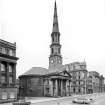Following the launch of trove.scot in February 2025 we are now planning the retiral of some of our webservices. Canmore will be switched off on 24th June 2025. Information about the closure can be found on the HES website: Retiral of HES web services | Historic Environment Scotland
Edinburgh, 3, 5, 9, 11 George Street, Standard Life Assurance Company
Commercial Premises (19th Century)
Site Name Edinburgh, 3, 5, 9, 11 George Street, Standard Life Assurance Company
Classification Commercial Premises (19th Century)
Alternative Name(s) Standard Allowance Company; National Bank Of Scotland; Standard Life; Myton Building
Canmore ID 113026
Site Number NT27SE 709
NGR NT 25471 74115
Datum OSGB36 - NGR
Permalink http://canmore.org.uk/site/113026
- Council Edinburgh, City Of
- Parish Edinburgh (Edinburgh, City Of)
- Former Region Lothian
- Former District City Of Edinburgh
- Former County Midlothian
This building now incorporates the site of the former no.13 George Street (listed seperately, see NT27SE 738).
Original building was designed by David Bryce 1838 (see NT27SE 709.01). This was demolished c.1898 and replaced with current building by J M Dick Peddie & G Washington Browne in three stages from 1897-1901.
NMRS REFERENCE:
3 George Street
Caretaker's House for Standard Life Assurance Company
PLANS:
Dick Peddie & MacKay, Edinburgh
Dick Peddie, Todd & Jamieson 1938
Standard Life Assurance Co
PLANS:
Dick Peddie & MacKay, Edinburgh extension
Dick Peddie, McKay & Jamieson n/d
REFERENCE:
Sources: Dean of Guild Bundle 1809 July-December 6.10.1809
Pet. John Bell, surgeon
No 9 George St
Plan enclosed for interior alteration - unsigned
Project (1997)
The Public Monuments and Sculpture Association (http://www.pmsa.org.uk/) set up a National Recording Project in 1997 with the aim of making a survey of public monuments and sculpture in Britain ranging from medieval monuments to the most contemporary works. Information from the Edinburgh project was added to the RCAHMS database in October 2010 and again in 2012.
The PMSA (Public Monuments and Sculpture Association) Edinburgh Sculpture Project has been supported by Eastern Photocolour, Edinburgh College of Art, the Edinburgh World Heritage Trust, Historic Scotland, the Hope Scott Trust, The Old Edinburgh Club, the Pilgrim Trust, the RCAHMS, and the Scottish Archive Network.
Field Visit (21 February 2002)
The five wise virgins are identical, in a row, bare-breasted, facing left (their right). To their left are the five foolish virgins, separate, clothed, in attitudes of despair and anguish.
The frieze is read from left to right. The Foolish Virgins represent (l to r): Wistfulness, Self-absorption, Panic, Despair and Procrastination. The Wise Virgins, 'being perfect, their transcendence has rendered them identical and equal' (1)
The parable of the ten virgins, Matthew, 25 (1-13)
Inspected By : T. S.
Inscriptions : In panel at left end of frieze (in raised letters):
ROTAS
OPERA TENET
AREPO
SATOR
Signatures : None Visible
Design period : 1975 (building) 1979 (sculpture)
Information from Public Monuments and Sculpture Association (PMSA Work Ref : EDIN0648)
Field Visit (13 March 2002)
The ten virgins in a pediment, the five wise virgins in the centre. The central figure holds her lighted lamp aloft. To her left (east) another holds a lighted lamp at waist level. The next virgin (east) stands with her back to us holding a lamp in her right hand. Beyond her is a kneeling foolish virgin and at the extreme right (east) is a sleeping foolish virgin. To the right (west) of the central figure is a standing wise virgin holding an oil bottle in her left hand, then a wise virgin holding a lighted lamp in her left hand and pointing with her right hand. At her feet is a foolish virgin on her knees, with a lighted lamp, asking for oil. Beyond her (west) another foolish virgin is on her knees facing (west) towards the last foolish virgin who is rising from sleep.
The original building was by David Bryce, in 1839. The pediment sculpture by Steell was carved for that building. In 1897-1901 a new building was erected by John More Dick Peddie & George Washington Browne. Steell's pediment was re-erected on this building.
On 13 January The Building News reported that the building was 'nearly completed in its cornice' and that preparation was 'being made for a decorative frieze.' (1) [See EDIN0647]
The parable of the ten virgins, Matthew, 25 (1-13)
Inspected By : T.S.
Inscriptions : Above entrance:
STANDARD LIFE INVESTMENTS
Signatures : None Visible
Design period : 1839 (pediment sculpture) / 1897-1901
Information from Public Monuments and Sculpture Association (PMSA Work Ref : EDIN0646)
Field Visit (13 March 2002)
A frieze of naked children with swags of flowers and fruit, running round the whole building (George Street and St Andrew Square)
On 30 June 1899, The Building News reported that 'the sculptors are busy with the elaborate frieze [which] comprises the well-known Classical garland of fruit and flowers, upheld by groups of youthful figures.' (1)
Inspected By : T. S.
Inscriptions : On frieze, below pediment on George Street, in raised letters: MDCCCXXV (1825 - the date of the company's foundation)
Signatures : None Visible
Design period : 1897-1901
Information from Public Monuments and Sculpture Association (PMSA Work Ref : EDIN0647)




























































